Defining semantic SEO and how to optimize for semantic search
The search landscape has changed dramatically over the past decade, with semantic web technology emerging as a key feature. Users now expect search engines to grasp natural language better than ever before. And yes, Google has achieved some remarkable accomplishments in language processing.
When search engines were less advanced, it rarely took one click to find precise answers to queries. Today, Google delivers extremely accurate results by interpreting the intent behind the user’s entire query and providing targeted, helpful answers quickly. This often includes instant responses in the form of AI Overviews or featured snippets.
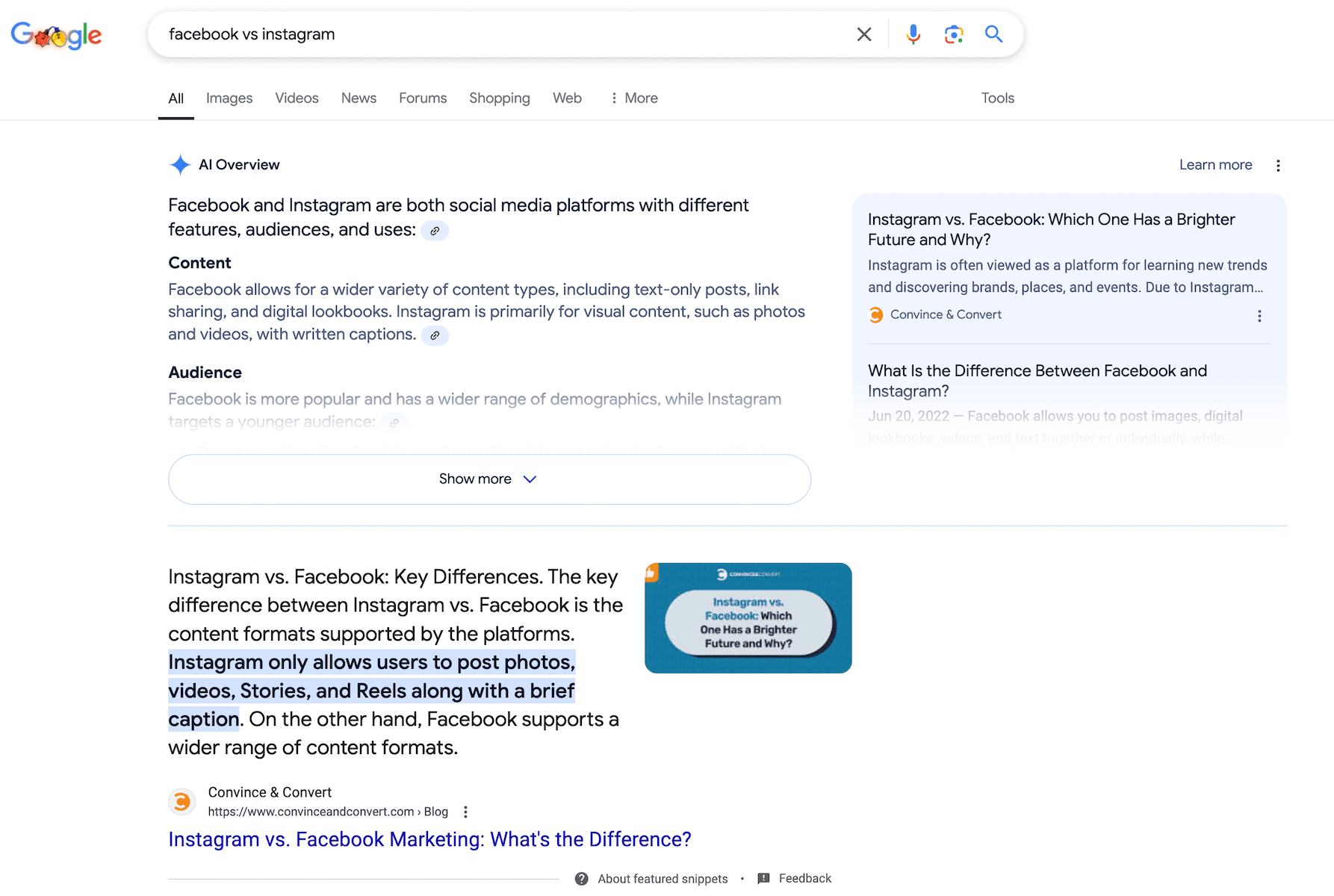
Download our free ebook to find out what keywords trigger AIOs and sign up to SE Ranking’s news and SEO tips digests!
Click the link we sent you in the email to confirm your email
-
Semantic SEO
Google’s system analyzes words, phrases, and their combinations to identify topical contexts and relationships. Entities and embeddings help search engines interpret and classify content accurately.
-
Focus on topics, not keywords
Shift from keyword-centric strategies to topic-based approaches. Utilize semantic keywords, relevant internal linking, and structured content to improve rankings.
-
Semantic keyword research
Use SEO tools and Google search features to compile related keywords, long-tail queries, and LSI keywords. Cluster keywords by topic, intent, and search volume for organized content planning. Employ models like pillar cluster, content hubs, or topic mapping for structured keyword grouping.
-
Content creation
Prioritize user intent and create content that is rich in value, not just lengthy. Use semantic markup for better structure and snippet optimization. Leverage SEO tools to analyze SERPs, optimize content, and incorporate AI for faster creation.
-
Internal linking
Build a logical internal link structure with descriptive, topical anchor texts. Ensure links connect related pages.
-
Structured data
Use structured data to help search engines understand and showcase your content in SERPs (e.g., Knowledge Graphs or rich snippets).
What is semantic SEO?
Semantic SEO is the process of optimizing your content for a topic rather than a single keyword or phrase. It looks into user intent, user experience, and the relationships between related entities and concepts. This approach helps search engines deliver more meaningful results and enhances the overall user experience in search.
Semantic SEO and entities
Since search engines are not human and don’t have an emotional connection to concepts and ideas like us, Google had to take, a mathematical approach to “explain the world” to them. This resulted in Google’s User-context-based search engine patent.
This system is designed to identify informational context by analyzing words, phrases, and their combinations. It divides information into distinct topics (domains) and identifies unique words or phrases that help classify the content. It creates a vocabulary list, where each word has a “context vector” based on its appearance rate in each domain.
When a topic belongs to a unique domain, Google can use its knowledge base to understand the topic’s meaning. It looks for related terms from that domain to determine the page’s topical context.
Also, note the importance of entities in this context, which are individuals, places, organizations, concepts, or any distinct object or idea that holds meaning.
Search engines use entities to better understand the relationships between different concepts and the contexts they appear in. Entities allow search engines to transcend literal keyword matching and grasp the intent behind a search query. For example, if a user enters a request containing “apple,” search engines can figure out whether they mean the fruit or the company by looking at the context and other related entities in the query.
This is possible thanks to embeddings, which help computers understand both the meaning of words (semantic) and how they are used in sentences (syntax). Embeddings transform words or phrases into numbers (vectors) by placing similar words closer together in a virtual space. For instance, in this vector space, words like “king” and “queen” appear near each other because they are strongly related. Instead of searching through all the data, these vector databases compare numerical representations (vectors) to find the closest match.
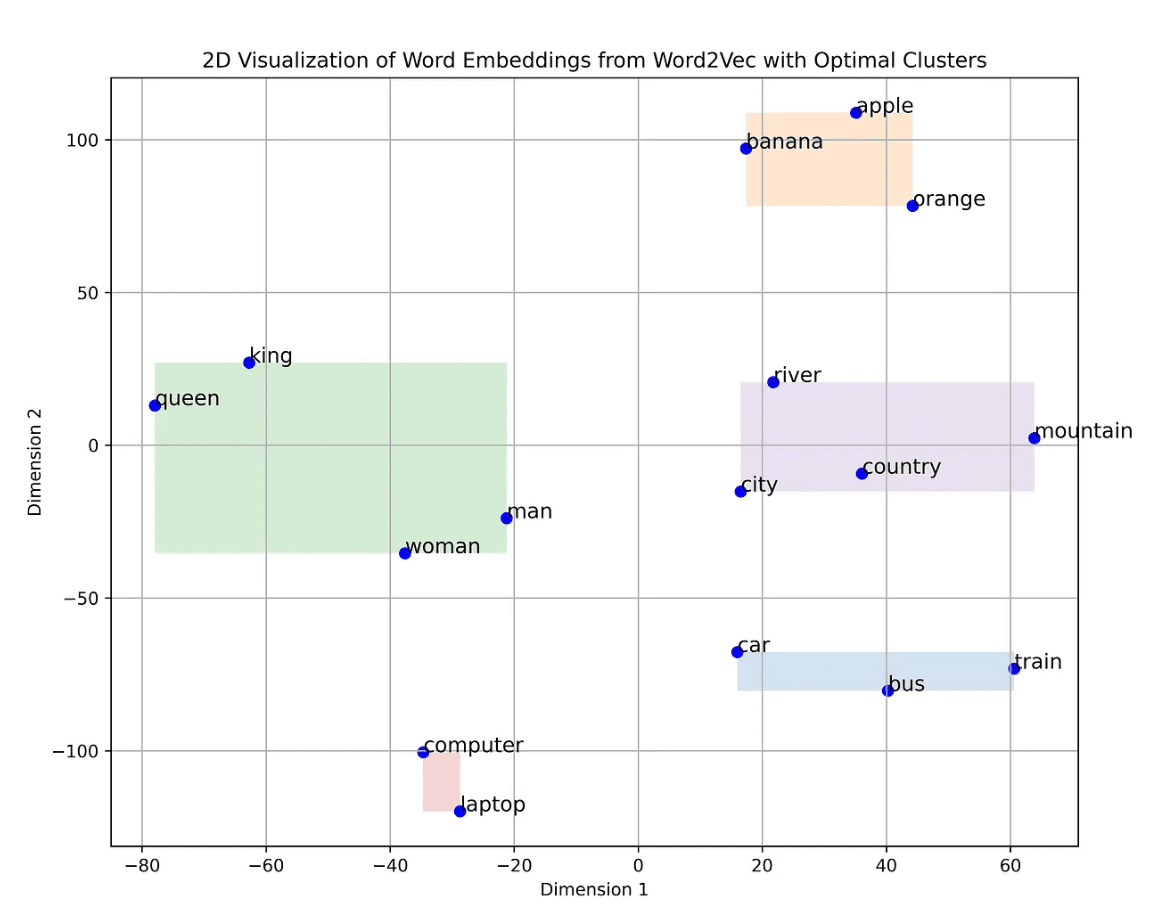
Google organizes entities and their interrelationships using a framework called the Knowledge Graph. This can be thought of as a vast network of interconnected domains on the subject matter. Here’s what it looks like:
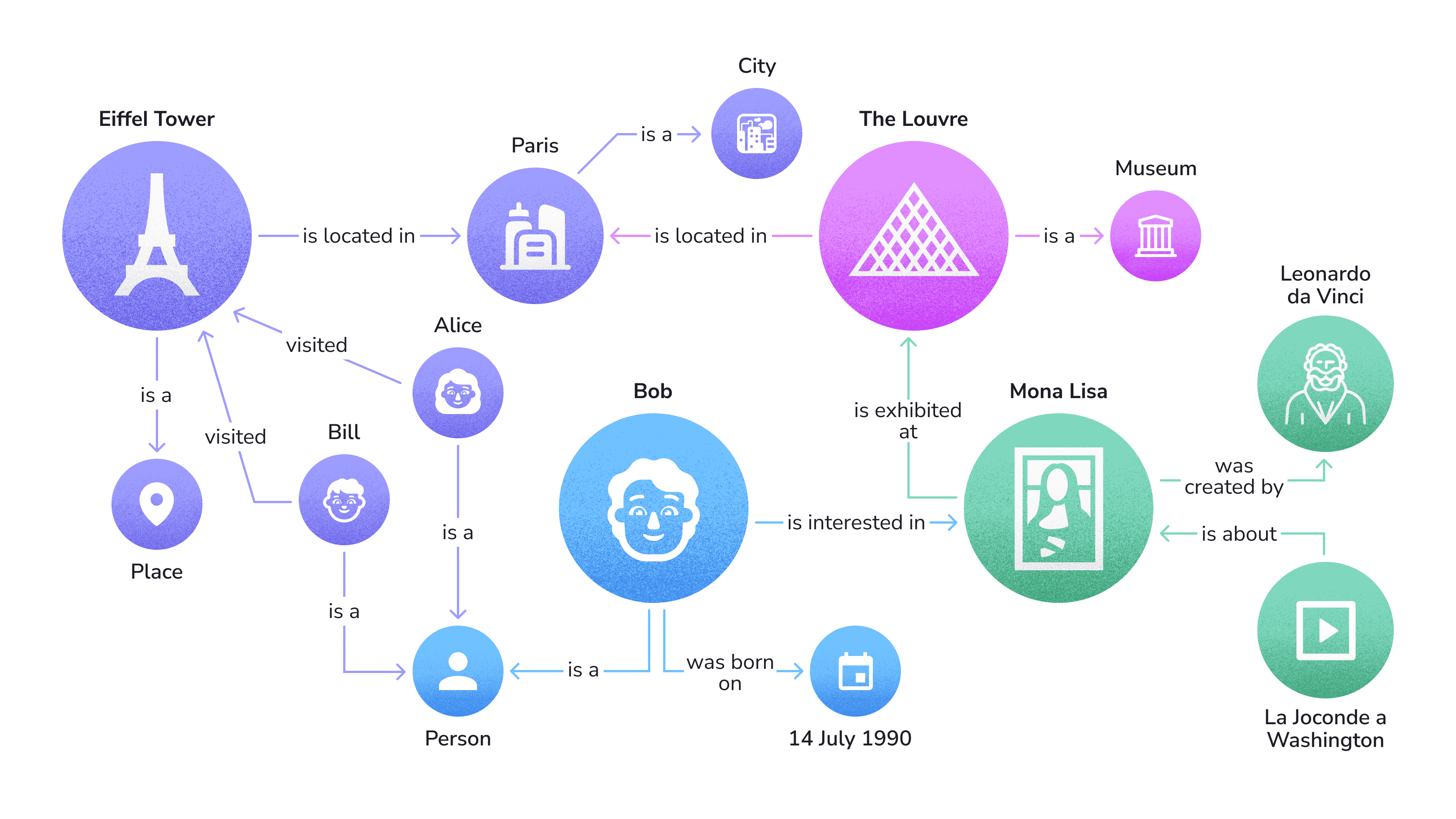
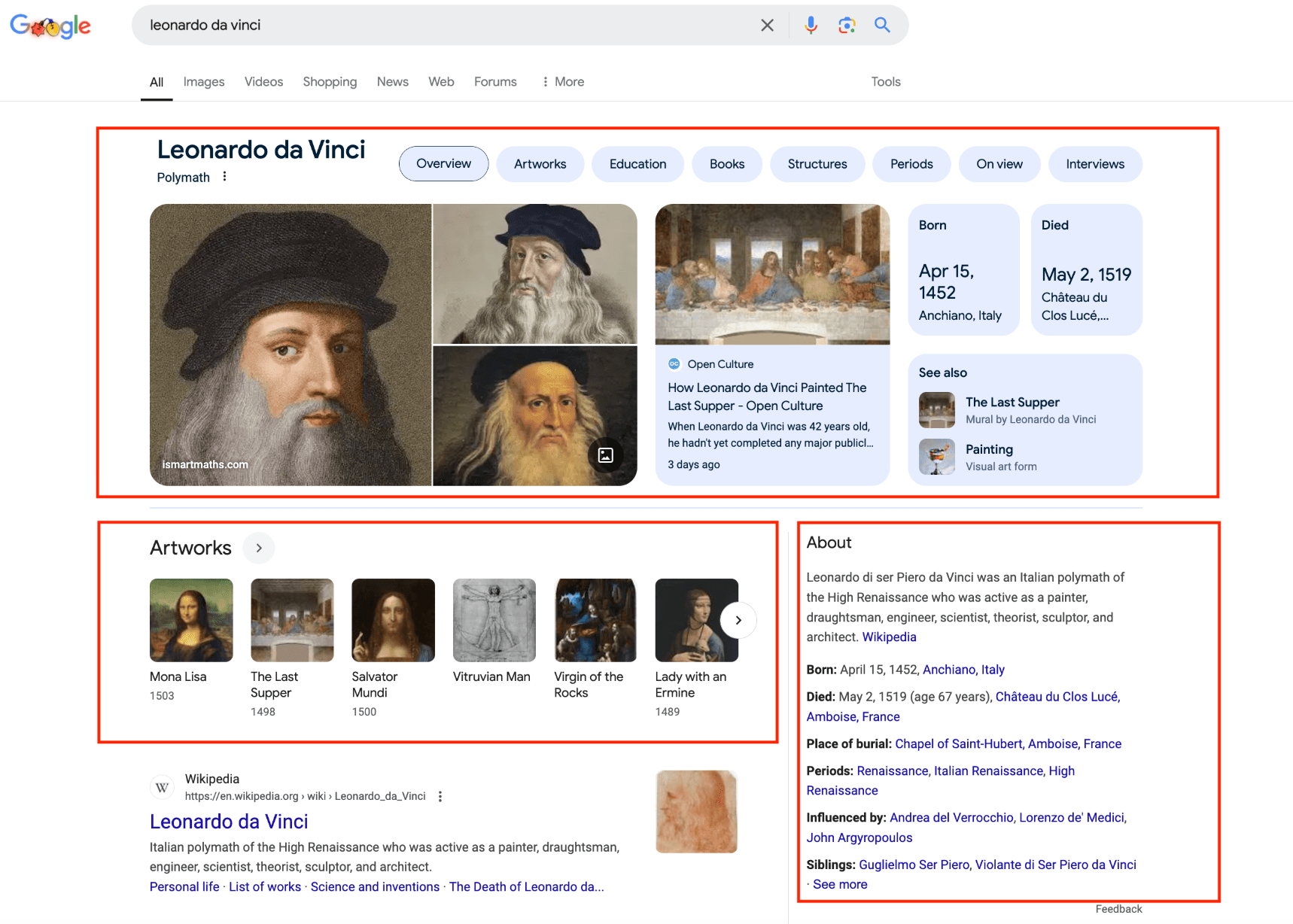
The main goal of semantic SEO is to build context on and around your page so its embedding aligns closely with the embeddings of users’ related queries in a vector space. This helps the mathematical model identify your page as relevant to the user’s query.
The impact of AI and NLP on today’s semantic SEO
To create compelling content and improve your site’s visibility in search results, you need to understand how Google ranks websites and displays information on SERPs.
The first (and most important) thing to remember is that Google has been steadily moving toward a more human-like, semantic SEO approach to understanding and ranking content.
Let’s take a detailed look at some of the biggest moves toward semantic SEO:
- Knowledge Graph: Since 2012, Google has used this large and sophisticated knowledge base to organize information and improve its understanding of the relationships between various entities and concepts.
- Hummingbird: In 2013, Google released an algorithm update that helps it better understand the meaning and context behind entire queries, minimizing its emphasis on distinct words.
- RankBrain: Since 2015, this machine learning algorithm helped Google better interpret search intent and provided users with more relevant search results.
- BERT: In 2019, Google introduced a groundbreaking technology that greatly enhanced search intent and conversational search. It emphasized words that were previously considered “less important” like conjunctions and their placements within queries. For instance, before BERT, a query like “British traveler to USA need a visa” likely wouldn’t have cared much about the word “to.” It would have generated US-centric results rather than relevant info for a British traveler. Google’s algorithm understands the intent better now and can generate more helpful SERPs.
But everything changed in 2023 with Google’s experimental breakthrough. On May 10, 2023, Google announced it was finally ready to reimagine the traditional search experience by integrating generative AI with it. The search engine began its testing phase of the Search Generative Experience, a feature that generates interactive AI snippets at the top of the SERP. On May 14, 2024 during the 2024 Google I/O, the search giant released SGE from beta and rebranded it as AI Overviews.
These dynamic snippets respond to user queries with verified answers and include links to relevant sources. For more details, check out this article on AI Overviews.
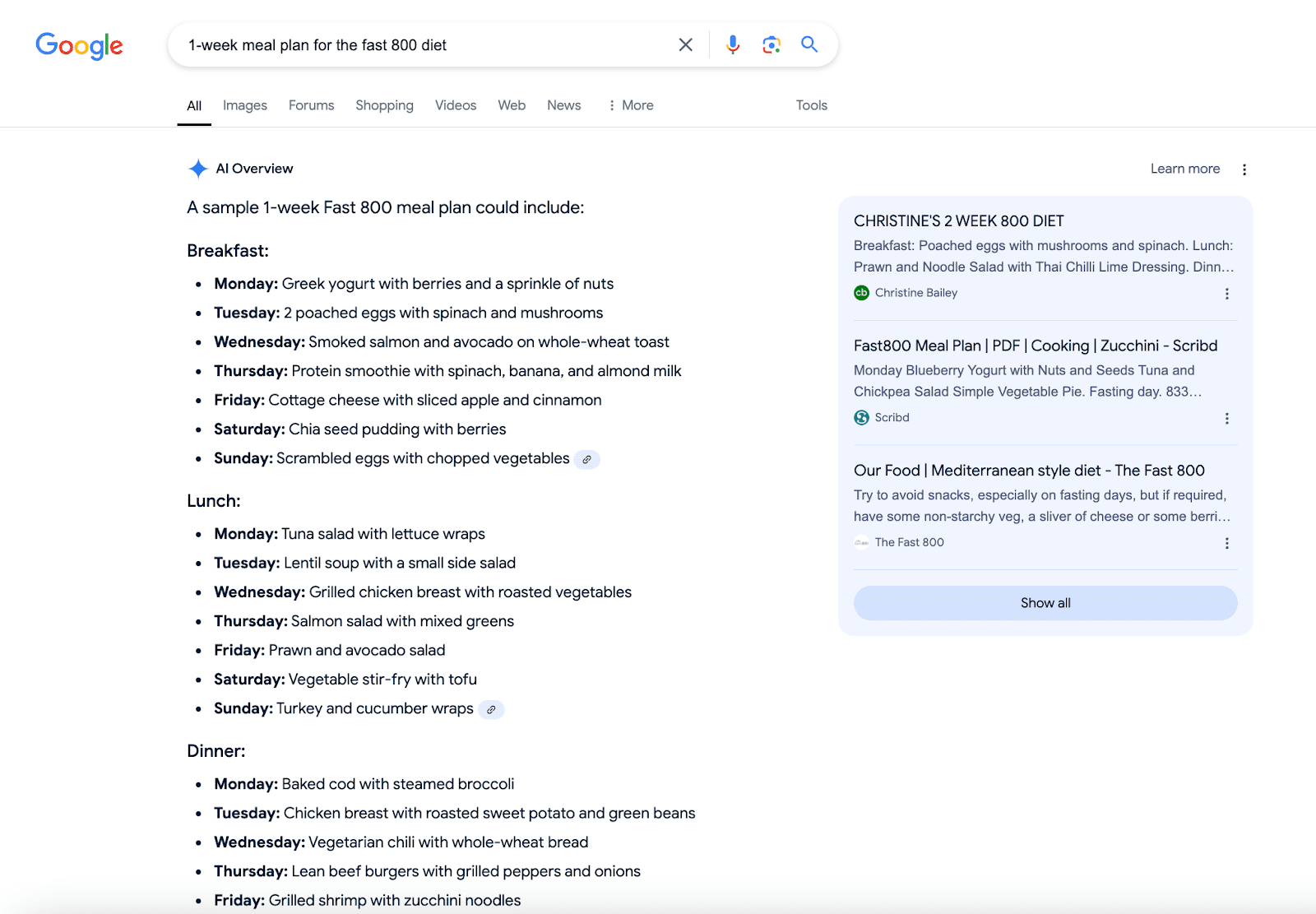
AIOs are now available in over 100 countries, with over 18.76% of keywords triggering them in US SERPs.
This feature’s full launch marked a monumental change in search and kicked off a new era of SEO, one that focused on optimizing websites for AI Overviews and generative AI platforms. This new strategy is called generative engine optimization (or GEO).
With generative AI capabilities incorporated into search, users can learn about a topic faster, get new viewpoints and insights, and accomplish tasks easier.
But Google’s experimentation with artificial intelligence doesn’t stop there. Let’s look at Gemini (formerly Bard), Google’s latest conversational generative AI chatbot. Google created it in direct response to the popularity of OpenAI’s well-known ChatGPT and was initially released at limited capacity in March 2023. Today, you can use Gemini as a chatbot. It can answer your questions or assist you with various tasks.
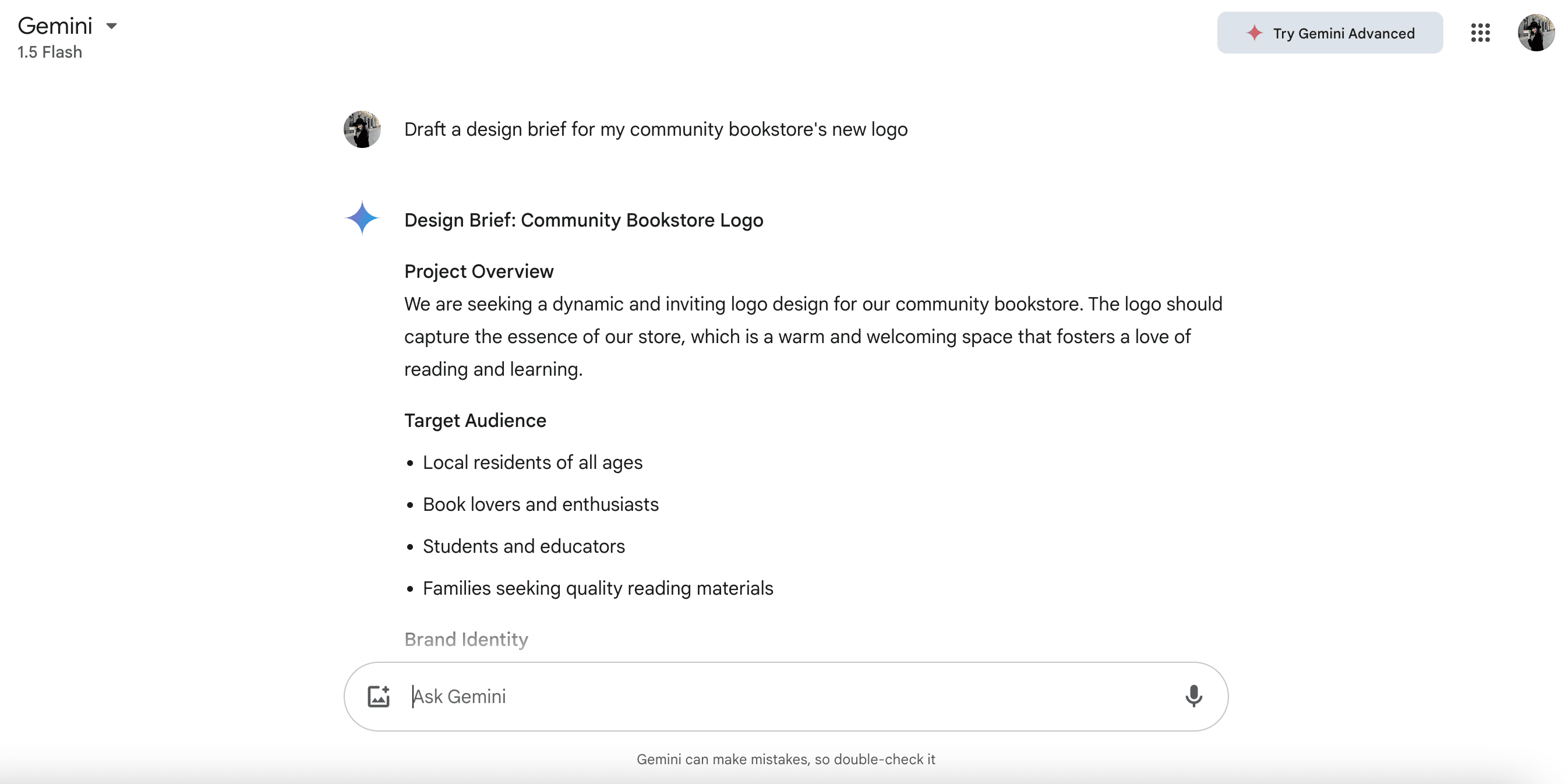
In January 2025, Google released its advanced AI assistant, Gemini 2.0, which is now available to everyone. One of the key improvements is the model’s doubled processing speed, enabling significantly faster responses. Google highlights that Gemini 2.0 Flash now handles complex tasks more effectively, delivers more accurate answers, and is even better suited for learning, writing, and programming.
Natural Language Processing has also taken the internet by storm, making it worth considering regarding semantic SEO. NLP plays a significant role in helping Google rank websites, drastically improving Google’s understanding of web content and user queries.
Here are some ways NLP contributes to Google’s website ranking process:
- Content Analysis: By using NLP techniques to examine the text, Google can extract important keywords, identify entities (such as people, places, and organizations), and determine the overall theme and topic of a page.
- Query Understanding: By analyzing the language used in search queries, Google can identify user intent and deliver more relevant search results.
- Semantic Search: NLP enables Google to move beyond mere keyword matching and comprehend the meaning of words and phrases within a broader context. Google can now grasp the relationships between words and deduce the intent behind complex queries.
- Natural Language Generation: Although not directly related to website ranking, Google employs NLP to generate featured snippets, knowledge panels, and other informative elements in search results.
AI and NLP are taking the tech world by storm, already drastically transforming semantic SEO. Search engines can now understand user intent more deeply and deliver incredibly relevant, precise results. Today’s specialists have no choice but to adapt their SEO strategies to these tech advancements—or get left behind. You can do this by focusing on high-quality content, improving user experience, and learning all about natural language.
Why is semantic SEO important?
Adopting semantic SEO practices future-proofs your SEO strategy and keeps you ahead of algorithm updates. Focusing on optimizing content for keywords and for the overall topic and user intent can help you reap the following benefits:
- You will send quality semantic signals to Google. Google understands that people may sometimes make life-altering decisions based on what they read online. This is why it strives to provide accurate, truthful, safe, and useful information. By maintaining accurate, up-to-date content, fully disclosing the topic, and meeting Google’s E-E-A-T criteria, you can make your page high-quality by Google’s standards and achieve higher rankings.
- Your content will rank higher. Semantic SEO helps search engines better understand webpage content. Giving search engines structured data markup and relevant semantic signals increases the odds of your website ranking higher in relevant search results and boosts your overall search visibility.
- You will rank for more keywords. Since semantic SEO goes beyond individual keywords and focuses on the broader context and intent of search queries, you can target a wider range of related semantic keywords. Understanding the relationships between different terms and concepts allows you to create content that aligns with user intent, capturing more organic search traffic and expanding your keyword reach.
- Your content will show up in SERP features. By utilizing structured data, you can establish semantic relationships to enhance your search engine result page listings. Rich snippets, such as star ratings, reviews, images, pricing information, and other relevant data, can make your listings more eye-catching and informative. Google might also display your content in SERP features like the People Also Ask block. These snippets provide concise answers to user queries and can drive more qualified traffic to your website.
- Your content will rank in AIOs and other AI-enhanced features. AI algorithms analyze content semantically, focusing on the meaning behind the text as a whole and not just the keywords. Optimizing for semantic SEO better aligns your content with AI’s ability to understand nuanced questions and provide accurate, contextualized answers. Features like AIOs pull concise, authoritative information from pages to provide quick answers. Structuring your content semantically, with clear headings, natural language, and well-researched insights, increases your chances of getting featured in Google’s AI summaries.
- Your visitors will stay on your website longer. Semantic SEO focuses on delivering more meaningful and relevant search results to users. By understanding user intent and providing precise answers or content that meets their needs, you can enhance the overall user experience on your website. And with page content that appeals to users, expect a much lower bounce rate. Users will spend more time on your pages, engage with them more often, and convert more reliably.
Embracing semantic SEO practices sets your website up for success within the evolving search landscape. You can drive more organic traffic, engage users more effectively, and ultimately achieve your online business goals.
Semantic SEO best practices
In old-school SEO, you could perform a site audit, choose a keyphrase, use it in your title/description, headers, and throughout the text, and then cross your fingers and hope to rank for it. However, if you’re a webmaster in today’s evolving search landscape, you’re going to come across some big challenges.
Fili Wiese, a technical SEO consultant at SearchBrothers and ex-Google engineer, suggests taking a more comprehensive approach.

Divide your work into three following stages to use semantic SEO properly: keyword research, content creation, and optimization.
Semantic keyword research
In the first semantic SEO stage, focus on choosing a topic based on user intent. Compile a list of relevant keywords.
Here is our recommended action plan for this stage:
- Create a keyword list. Compile a list of related keyphrases and LSI keywords that are semantically related to your target keyphrase.
- Perform semantic analysis. Use tools to analyze keyword relationships, uncover hidden connections, and align your content with user intent.
- Identify long-tail keywords. Identify long-tail keywords that address your topic and have a clear intent.
- Systematize your keyword list. Organize your keyword list by combining similar queries into groups. This process is called keyword clustering, or grouping.
Use Google to create a keyword list
While you shouldn’t get keyword ideas from Google alone, it is a good place to start.
To kick things off, think of the keywords you want to rank for in Google. Let’s say you run a yoga studio in LA. You definitely want to rank for such commercial keywords as “yoga school” or “yoga studio LA”, but you also want your blog to rank for all sorts of informational keywords like “downward-facing dog” or “meditation techniques”. And here’s how you can find all of the most popular queries.
Several suggestions will appear after you type “yoga” into the Google search bar. Each is a mix of trending semantic keywords on Google with suggested search terms based on your search history.
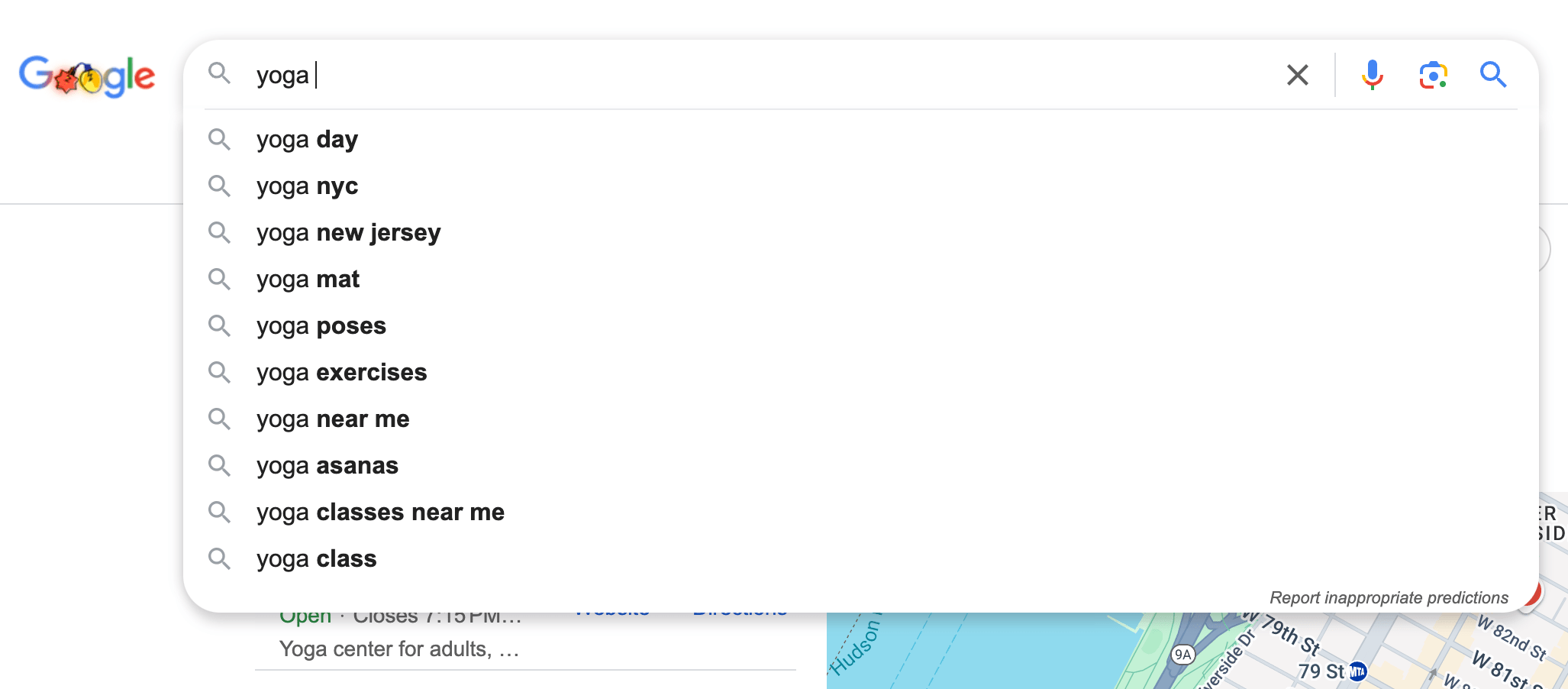
Don’t forget to add long-tail keywords to your list. These queries are generally well-thought-out and take the form of questions and sentences.
Consult the “People also ask” section and enter those queries into Google search to check for any autocomplete results.
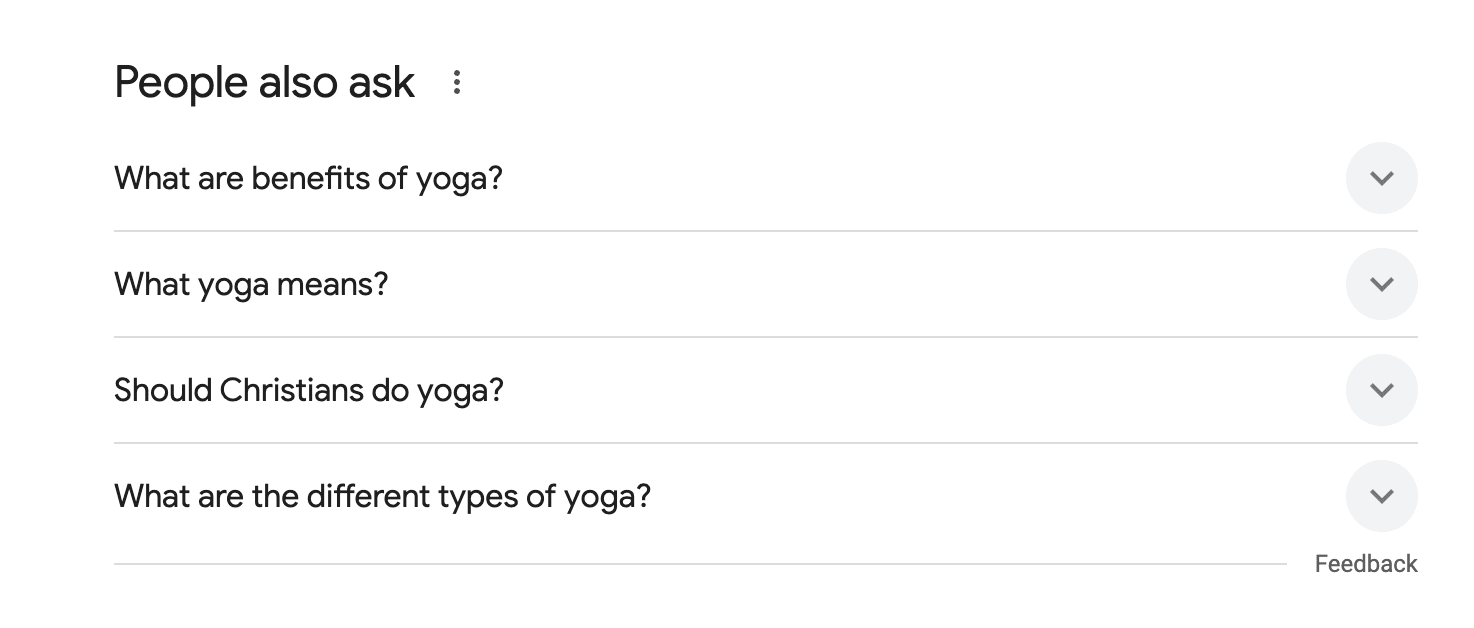
Alternatively, you can scroll down to the bottom of the first page of this SERP to find a list of related search queries. These can bring you long-tail keyword ideas.
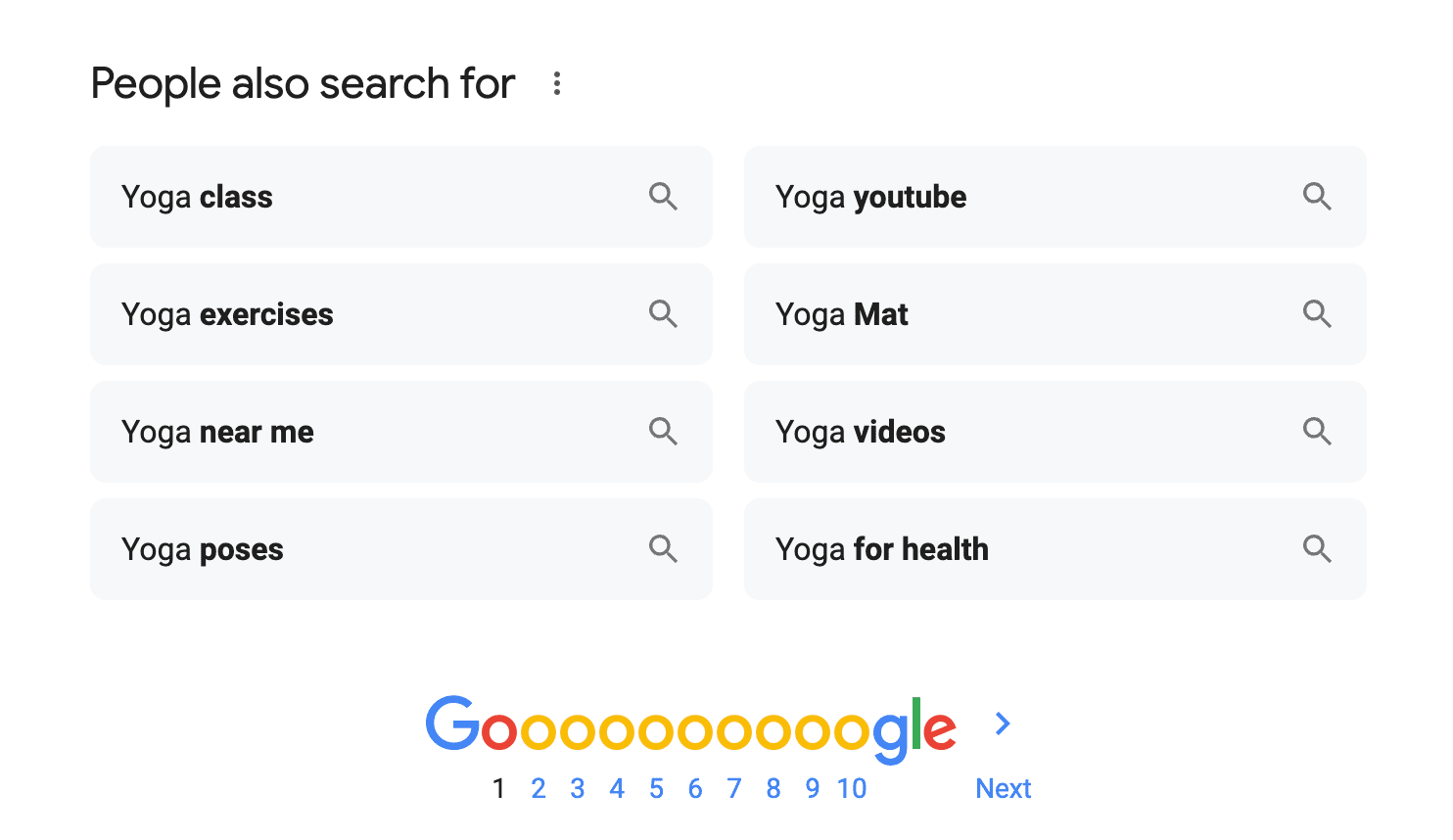
Google Search also lets you look for synonyms and LSI keywords. Although these keyword types are often confused with one another, keep in mind that not all related search terms are synonyms.
For example, “yoga asana” and “yoga pose” are synonyms. The search term “yoga class”, however, is only related to the previous phrases and does not have the same meaning.
You can find synonyms and LSI phrases either by using an autocomplete feature or looking at the bottom of the SERP.
You can keep exploring to gather all the queries Google has to offer. Looking at these keywords might even spark some ideas for related queries of your own.
To support a strong semantic SEO strategy, it helps to understand how search interest evolves over time. Our Google Trends for SEO guide shows how to use trend data to identify timely topics, seasonality, and related search queries that support broader semantic relevance.
While using Google is a time-tested way of collecting semantic search data, you can also use semantic SEO software to speed things up and get better results.
Search for keywords with SE Ranking
SE Ranking’s Keyword Planner has a huge database that goes beyond search engine suggestions. It hosts over 4 billion unique search queries, which means you can generate thousands of keyword ideas in one click.
Each keyword has plenty of metrics, including its Google search volume, which is the number of monthly searches it gets. The yoga topic, for example, has 550K monthly searches.
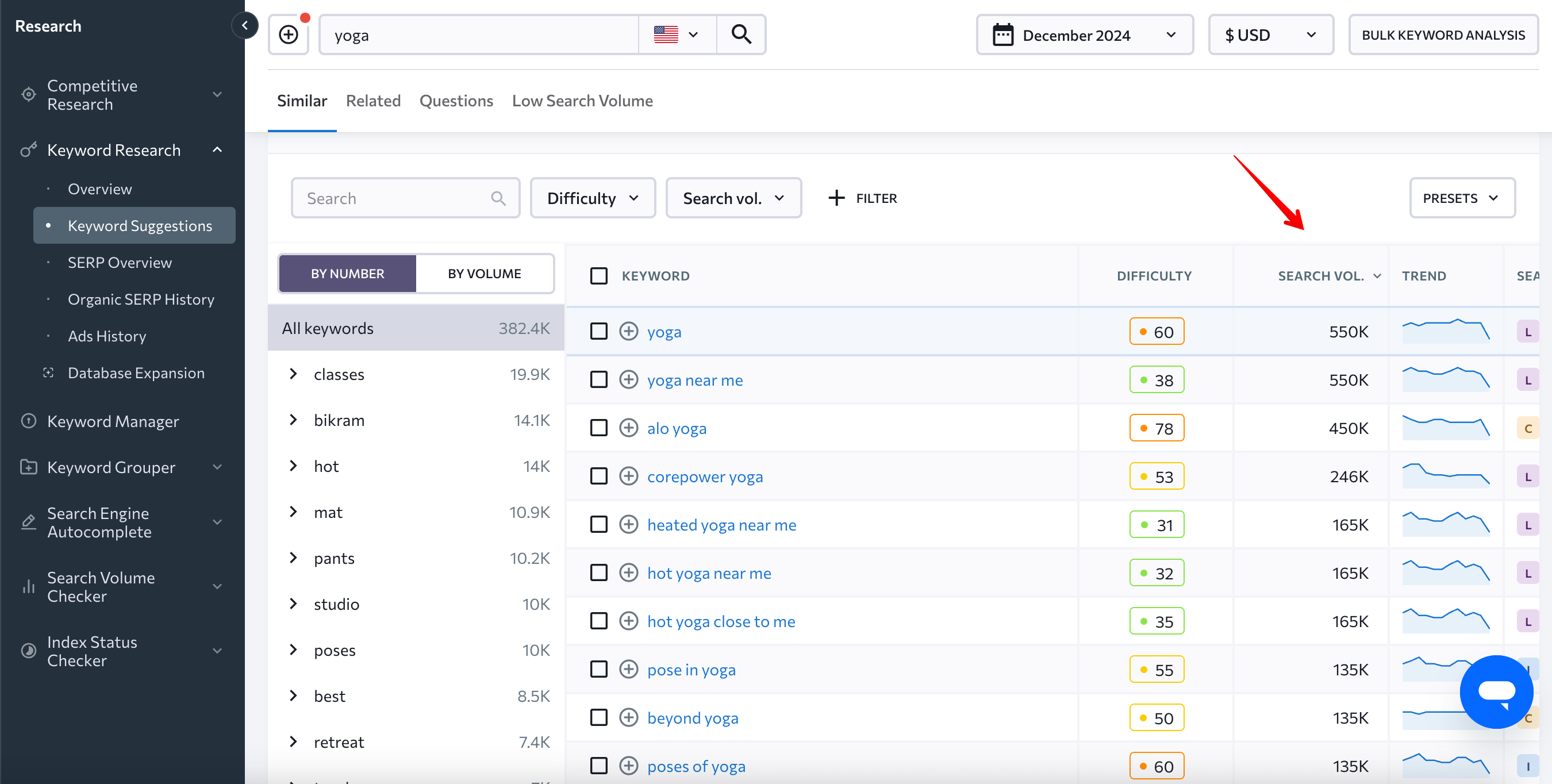
You can use filters to leave out keywords that you don’t intend to rank for. For example, it’s possible to filter out keywords with super high search volumes. These keywords are generally too vague and overly competitive.
For more ideas, go to SE Ranking’s Related, Questions and Low Search volume tabs. While the Similar keywords tab only features search terms with variations of the seed keyword, the Related keywords tab presents a wide range of semantically related queries.
SE Ranking also lets you perform competitor research to draw keyword ideas. You don’t even need to choose which competitor to analyze—the Competitor Research tool will identify your top SEO rivals and come up with a list of keywords that you’re not ranking for but your competitors are. This helps you discover some of the more obscure but useful topics related to your business niche.
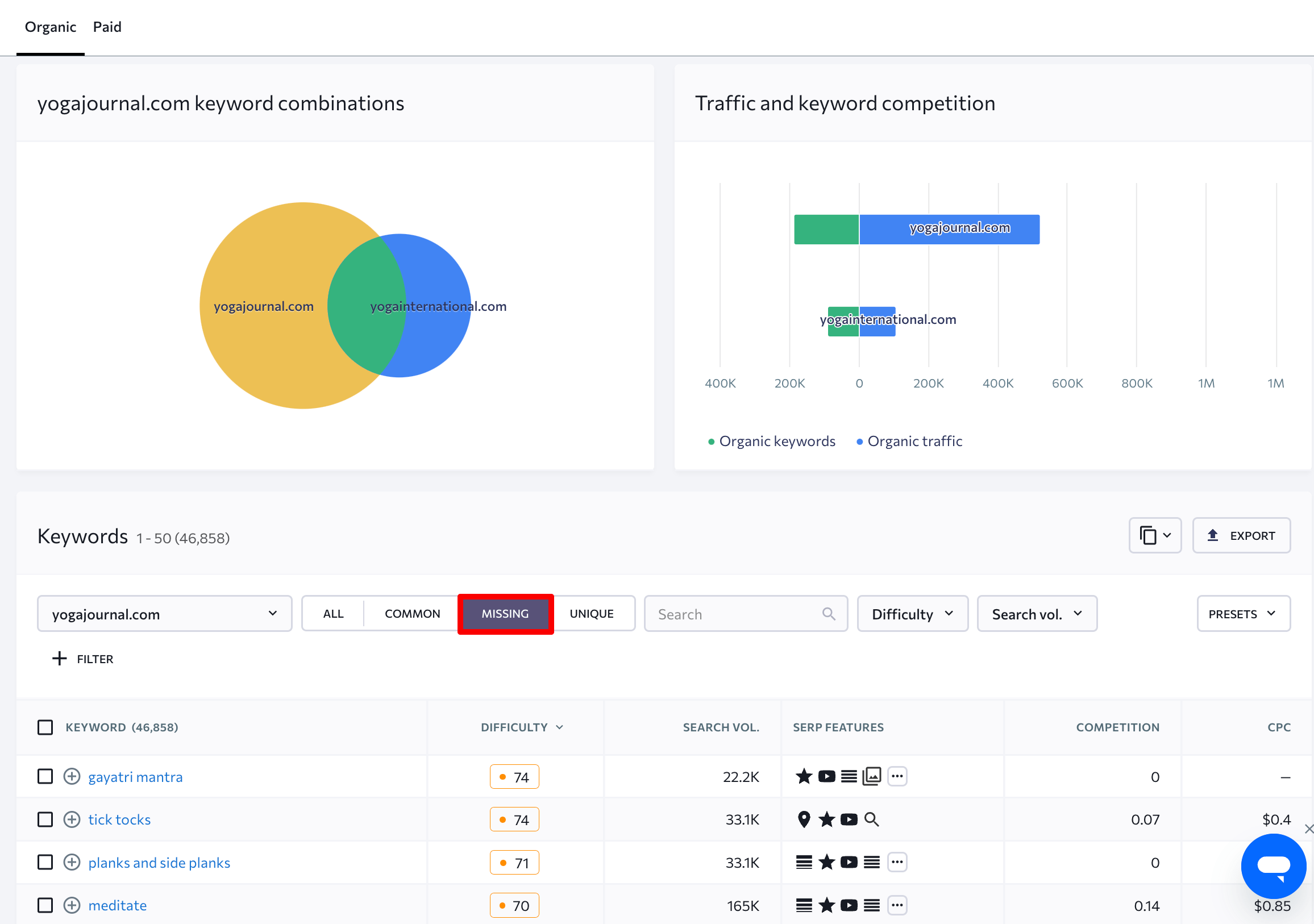
Cluster all of your keywords
Once you’ve gathered your keywords from all possible sources and compiled them into a spreadsheet, remove any duplicates. Now you can move on to keyword clustering.
Observe your list closely and think of ways to categorize keywords into different groups.
Let’s say, for example, that you have a long list of keywords about “yoga asanas”.
Here are some ways to group them:
- By their semantics: “yoga poses”, “yoga postures”, “asanas list”, etc.
- By user intent: “how to do yoga asanas”, “what are the beginner yoga poses”, etc.
- By search volume: high-volume keywords versus low-volume keywords, etc.
Grouping keywords by search volume helps you in structuring your website. Think of high-volume keywords as categories, and low-volume keywords as potential article topics or service/product pages.
Semantic search engine optimization entails creating content clusters based on topics rather than keywords. Use the pillar cluster model, content hub, and topic maps to group content according to semantic SEO principles.
To apply the pillar cluster model, group keywords by topic for each page. This method organizes topics by grouping more specific subtopics under a broader main topic. This allows you to group keywords around a central theme while breaking them into multiple distinct pages. Topic clusters help search engine bots understand the context, relationship, and hierarchy of each page within a structured content framework.
Once you have grouped keywords by their main themes and supporting subtopics, you can use the content hub method to organize them on your website. Content hubs are centralized collections of all your content on a specific subject, designed to serve as a comprehensive resource. The hub comprises the pillar page, which covers the broadest aspects of the main topic, and supporting pages that explore specific subtopics in detail. These pages are connected with hyperlinks.
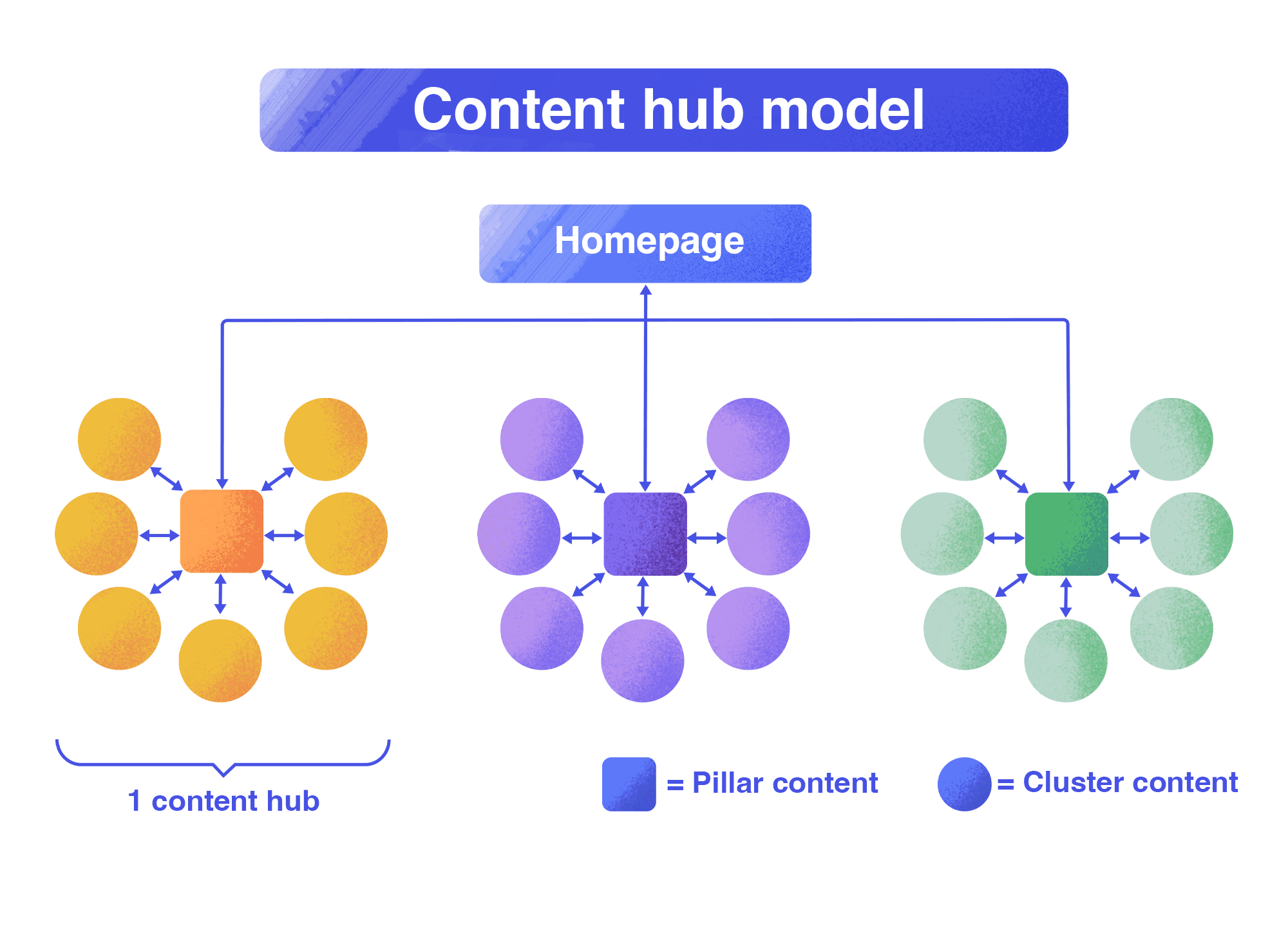
Another method for clustering your keywords and structuring your content is topic mapping. This is similar to the knowledge graph, where pages are grouped and linked based on associations, which represent relationships between topics. Unlike the pillar and content hub methods, there is no distinction between the primary and supporting content. This approach is designed to connect topics in a semantically meaningful way.
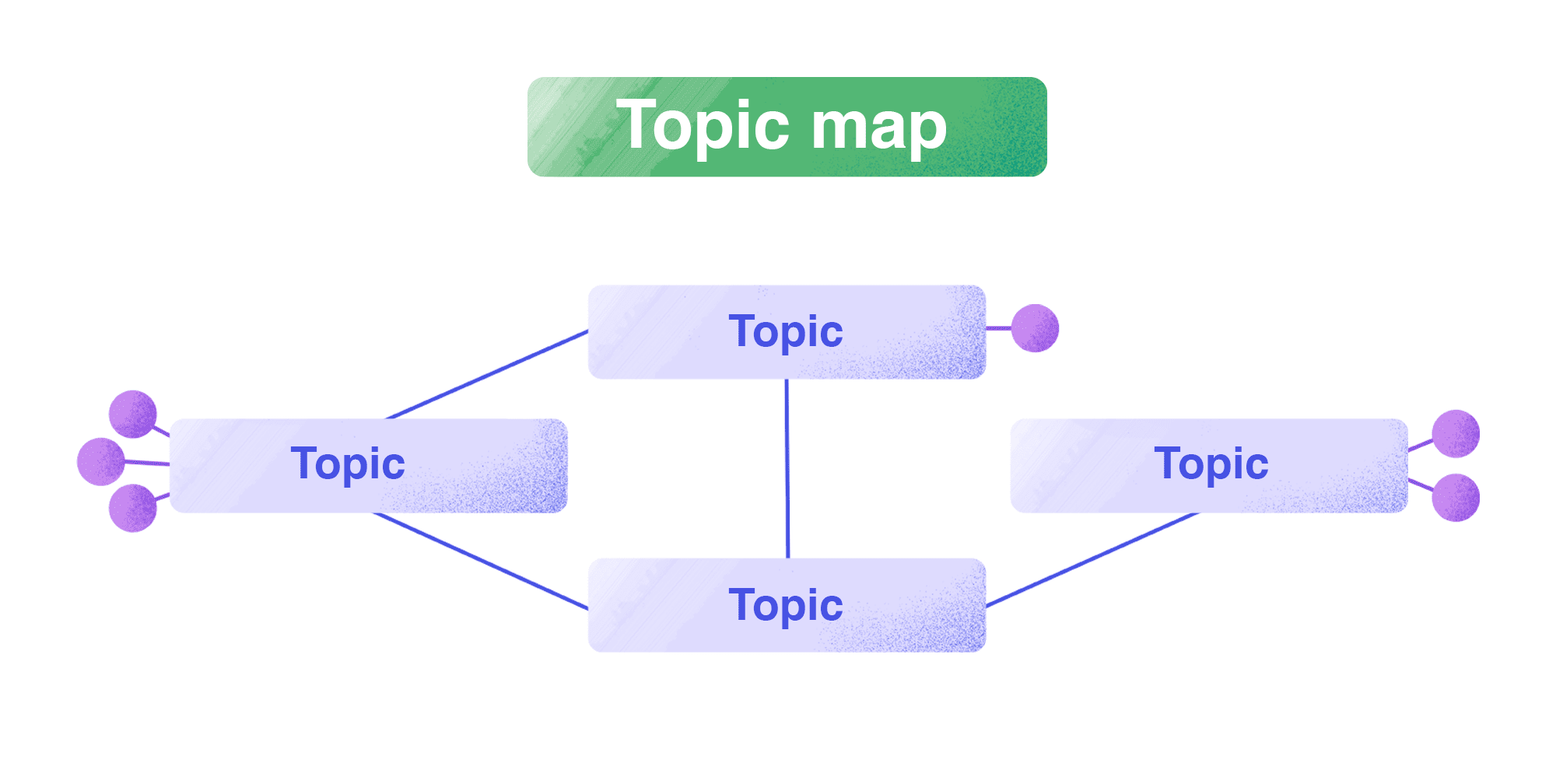
Note that all of these cluster methods are unique, but each can organize your content effectively while avoiding keyword cannibalization.
That’s it for traditional keyword research and clustering. You can brainstorm ideas using search engines or streamline the process with SE Ranking. Then you can add new topics to your content plan and group pages by theme.
Content creation
Now that you’ve gathered all your keywords and topics, let’s explore how to write content with semantic search in mind.
Use semantic markup
Semantic markup is just as critical to achieving higher rankings as performing careful keyword research.
Semantic markup, also known as semantic HTML, is a set of elements that clearly outlines the structure of your content and gives it meaning.
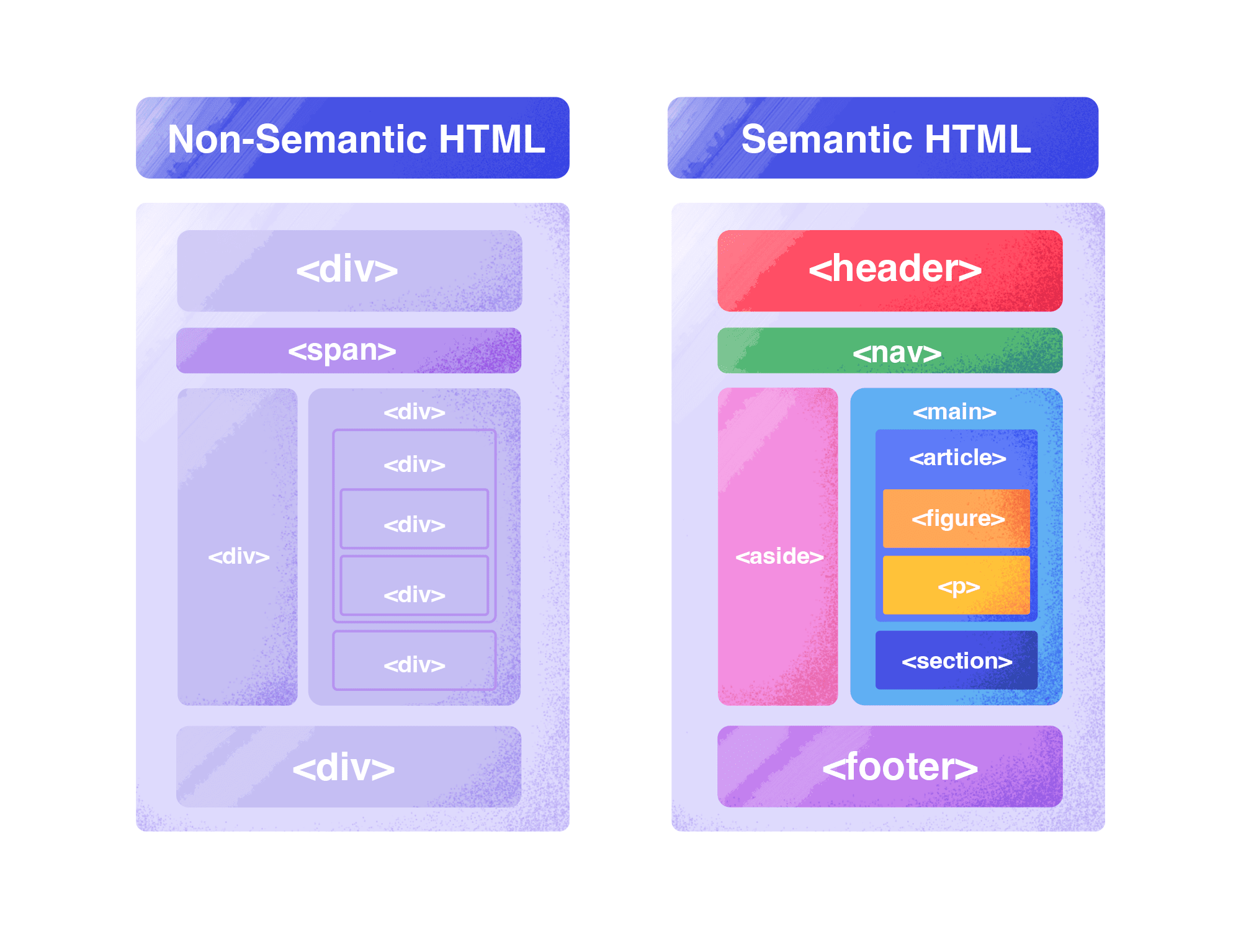
For example, an <h1> tag indicates that the embedded phrase is the title of your article. This is both presentational and semantic markup because it shows users and search engines where the title is.
Here are some examples of semantic HTML tags:
- <h1> through <h6>
- <blockquote>
- <form>
- <table>
- etc.
Semantic elements can help some parts of your content, like lists, appear as featured snippets.
Make your content richer, not longer
Simply stuffing your content with keywords won’t cut it anymore. These days, the content around your keywords must meet user intent to rank high. Think about the topic, not just the keywords, and make sure you’re meeting your customers’ needs and not mindlessly inserting key phrases into your content.
Here’s what Lee Wallis, Head of Digital at Excite Media, Winner for SEO—Australian Web Awards 2021, suggests:

Whenever possible, try to prioritize evergreen content.
Use special tools to learn how to optimize your content
Specialized tools can enhance your semantic writing process and increase your chances of success against your competitors. Plenty of content tools are available to help with semantic SEO automation, saving you time and money by generating and optimizing text for search. We’ll go over how to use them, specifically SE Ranking’s Content Creation Tool.
Begin by analyzing SERP content. The tool observes top competitors to determine how many words, headings, paragraphs, and images (such as infographics) your article should have. It also provides relevant keywords and key phrases.
Second, structure your content around your competitors’ best practices. Content Editor pulls headings from your competitors’ pages so you can incorporate them into your article or use them as inspiration as you plan and outline your content structure.
Third, use AI tools to expedite content creation. You can generate topics, headings, and paragraphs in mere seconds with AI Writers.
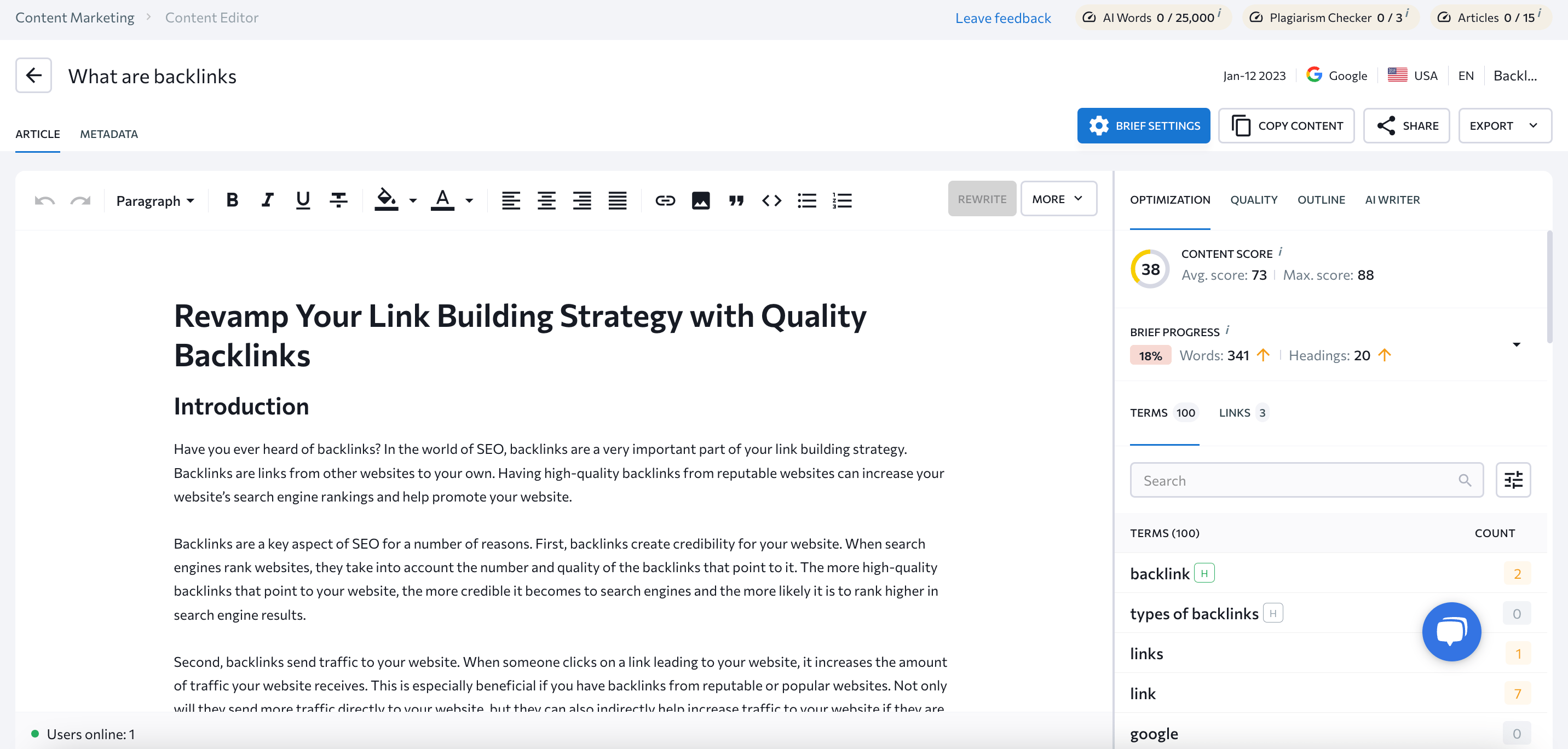
Next, respond to the tool’s content improvement recommendations, specifically on keyword usage, readability, grammar errors, and plagiarism. Use this instant feedback to refine and optimize your content as you progress.
From SEO optimization and keyword analysis to real-time content analysis and collaboration features, this tool improves your content’s quality, visibility, and search engine rankings.
Internal linking
Let’s move on to finetuning your semantic SEO writing with strategies around internal linking, including placing relevant anchor texts, and more.
Carefully constructing your internal link structure helps your content appear in the right place in search.
This structure contains three elements:
- Menu link structure
- Breadcrumb link structure
- Internal link structures in the body of the article
Linking pages together helps readers navigate your site while giving Google a clear idea of how to crawl and discover new pages on it. For example, a company that sells sneakers can have a basic “sneakers” page that appears higher in search results than a “kids sneakers” page for the query “sneakers for kids”. This seems illogical. However, if the main category links to the “kids sneakers” page, it can help Google prioritize the subcategory page for the given query.
In other words, with a smarter internal linking structure, the better your site will perform for both Google and users.
When setting up internal linking, make sure that your page contains topical anchor texts.
In the HTML code of a page, an anchor text looks like this:
<a href=”https://www.example.com”>Anchor Text</a>
Let’s say your page has a lot of links with anchor text about bikes. Google will use this information to determine the topic of the page your links point to. Here are some tips for working with anchors in semantic SEO:
- Use descriptive anchor text: It must reflect the meaning of the linked page to both users and search engines.
- Incorporate long-tail keywords: This keeps things natural.
Structured data
To help Google better understand your content, use structured data—a format for classifying page content. Structured data acts as a language that conveys the context behind your content to search engines. Google uses this information to make your content more attractive to users on SERPs.
Let’s look at the AccuWeather website. Google’s Knowledge Graph covers basic information about their company, including when it was founded, who the founder is, the headquarters, etc.
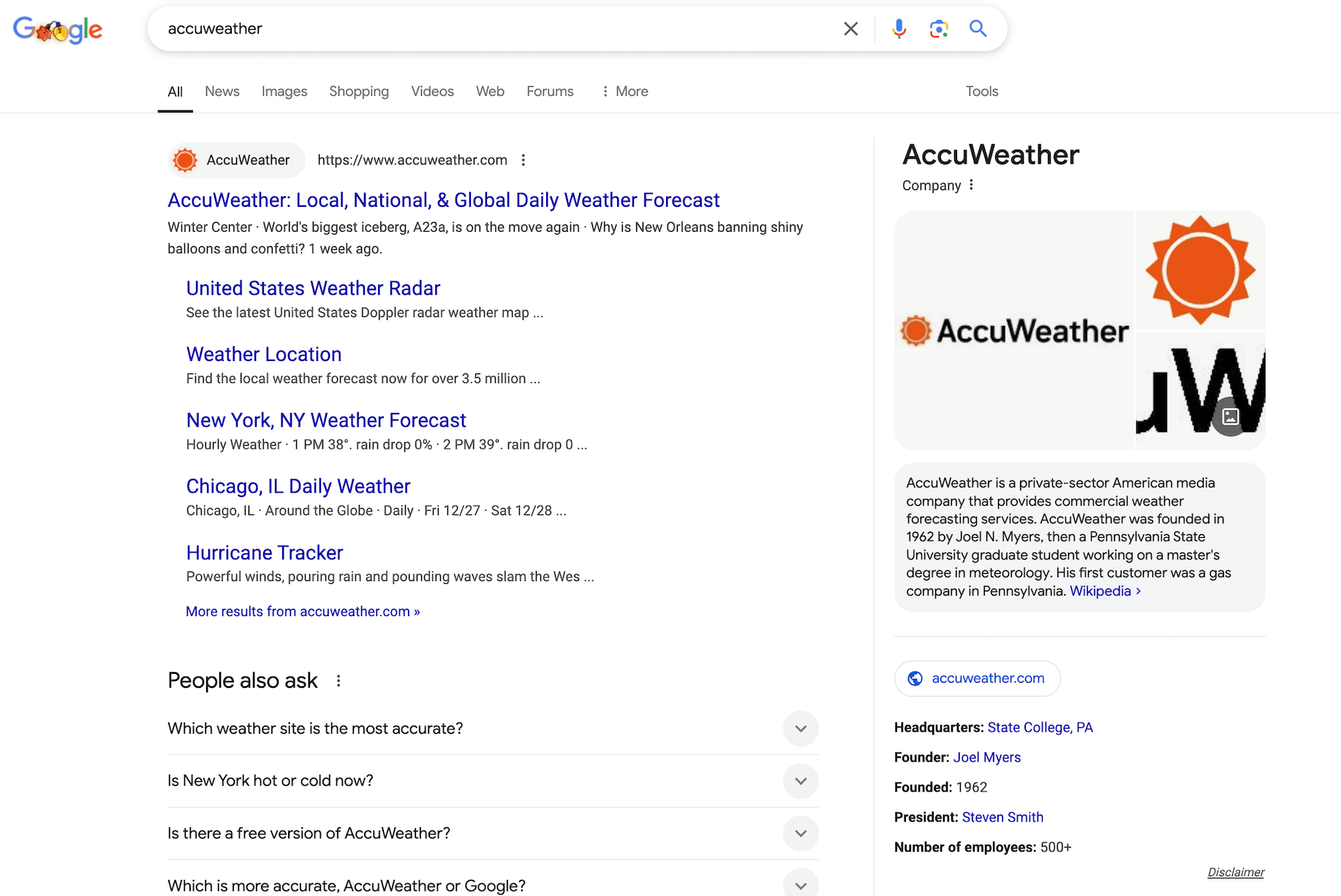
AccuWeather included structured data to help Google understand its page content.
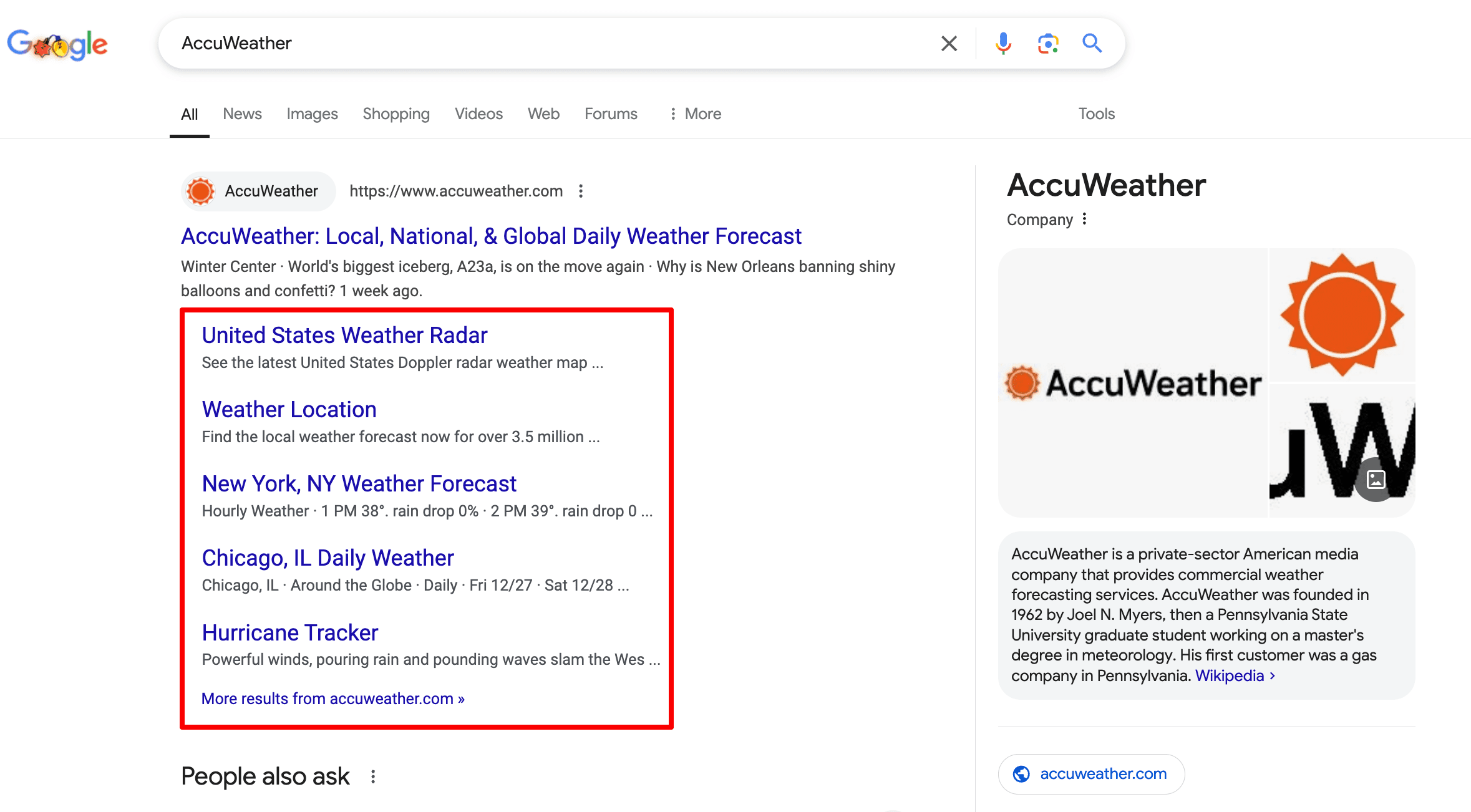
Users can see pressing news directly in search results because its structured data identifies individual elements of weather forecasts.
Conclusion
Creating and optimizing content for search is all about relevance and value. Even if your page is technically flawless and includes relevant keywords, it won’t rank high if the content doesn’t fully address the intended topic.
The fundamentals of semantic SEO strategy are that you must optimize your content for Google’s proper understanding of it, adapt your pages to natural language search, and answer as many related and relevant questions as you can. This way, you can ensure your content reaches the top of the search results, including AI Overviews, to provide a quick and clear answer to the user’s query. That is Google’s main goal.

